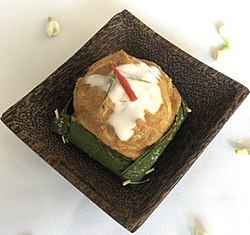 Fish amok served in a banana leaf container | |
| Alternative names | Amok trei, amok trey |
|---|---|
| Type | Steamed curry |
| Place of origin | Cambodia[1][2][3] |
| Serving temperature | Hot |
| Main ingredients | Goby fish, snakehead fish or catfish, yellow or green kroeung, coconut cream or coconut milk, eggs |
Fish amok or amok trei (Khmer: អាម៉ុកត្រី [ʔaːmok trəj]) is a Khmer steamed fish curry (amok) with a mousse-like consistency, considered one of Cambodia's national dishes. Fish amok is believed to have been a royal Khmer dish dating back to the Khmer Empire,[1][2] although some question it originating in Cambodia.[4]
- ^ a b Gillan, Audrey (7 September 2017). "Cambodia: the art of amok". National Geographic. Archived from the original on 18 September 2021. Retrieved 4 October 2019.
- ^ a b Dunston, Lara (23 May 2017). "Cambodian Fish Amok Recipe – an Authentic Steamed Fish Curry in the Old Style". Grantourismo Travels. Archived from the original on 17 June 2022. Retrieved 4 October 2019.
- ^ "Michelin-starred chef David Thompson explains his growing love for Cambodian cuisine". Aqua Expeditions. June 13, 2019. Archived from the original on August 3, 2021. Retrieved May 26, 2021.
If the description of fish amok sounds like Thai cuisine (arguably the most popular Southeast Asian cuisine in the world), that's because many elements of today's Thai cooking was influenced by Khmer cooking techniques and principles perfected over centuries.. (...) A dish that exemplifies Khmer influence, is fish amok, a steamed snakehead fish curry that is redolent of lemongrass, galangal and coconut aromas.
- ^ Lees, Phil (May 25, 2007). "The Dish: Fish Amok". The Wall Street Journal. Archived from the original on 2 November 2021. Retrieved 7 October 2019.
The origins of fish amok are a source of regional debate. Dishes of this kind aren't unique to Cambodia. Malaysia and Indonesia boast the similar otak otak and Thailand cooks a spicier hor mok but neither nation embraces them with the passion of Cambodia. "Amok" in the Cambodian language, Khmer, only refers to the dish whereas in Thai, "hor mok" translates as "bury wrap," suggesting amok may have come from Cambodia's neighbor.